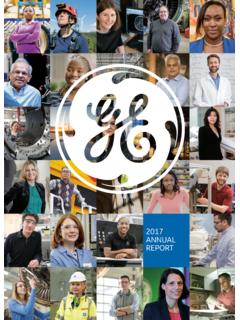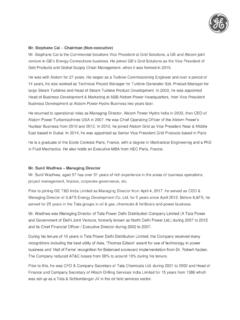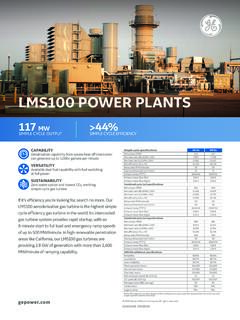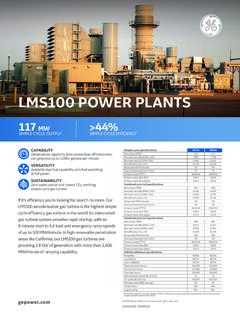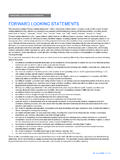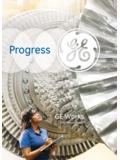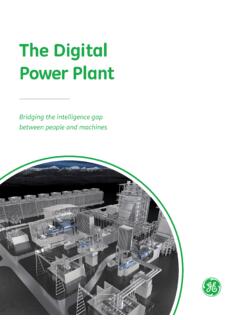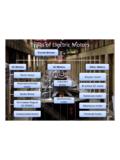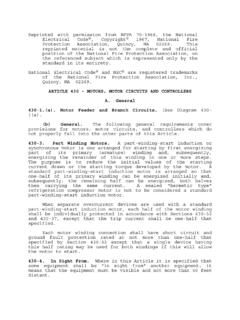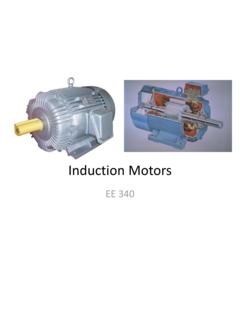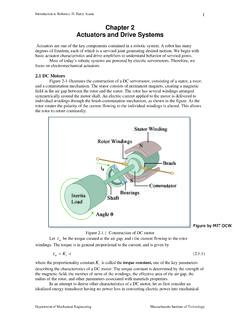Transcription of GER-4212 - GE Generator Rotor Design, Operational Issues ...
1 G GER-4212 . GE Power Systems GE Generator Rotor Design, Operational Issues , and Refurbishment Options Ronald J. Zawoysky Karl C. Tornroos GE Power Systems Schenectady, NY. GE Generator Rotor Design, Operational Issues , and Refurbishment Options Contents Overview ..1. Function of a Generator Rotor ..1. Types of Generator rotors ..4. Conventional Windings ..4. Generator rotors with Aluminum Alloy Windings ..5. Direct-Cooled Windings ..5. Radial Flow Cooling ..5. Radial-Axial-Radial Cooling ..6. Diagonal Flow Cooling ..7. Laminated rotors .
2 7. Current 4-Pole Salient Pole rotors ..8. Problems Encountered with Generator rotors ..8. Shorted Turns and Field Grounds ..8. Thermal Sensitivity ..10. Contamination ..11. Collector, Bore Copper and Connection Problems ..12. Copper Distortion ..12. Forging Concerns ..12. Retaining Ring Concerns ..13. Misoperation ..15. Generator Rotor Reliability and Life Expectancy ..15. Generator Rotor Life ..15. Generator Experience ..16. Generator Rotor Refurbishment and Replacement ..16. Generator Rotor Rewind ..16. Reasons for Rewinding.
3 16. Types of Insulation ..17. Generator Rotor Modifications, Upgrades and Uprates ..18. Impact on Other Components ..19. Generator Rotor Replacement ..20. Exchange Field ..20. New Field ..20. GE Power Systems GER-4212 (08/01). i GE Generator Rotor Design, Operational Issues , and Refurbishment Options Rewind, Refurbishment and Replacement Recommendations Versus Risk ..20. New Replacement Rotor ..20. Exchange Field ..20. Rewind with New Copper ..21. Rewind Reusing Old Copper ..21. High Speed Balancing ..21. High Speed Balance.
4 21. Flux Probe Test ..21. Thermal Sensitivity Test ..22. Conclusion ..22. Frequently Asked Questions ..22. List of Figures ..24. List of Tables ..24. GE Power Systems GER-4212 (08/01). ii GE Generator Rotor Design, Operational Issues , and Refurbishment Options Overview Rotor reliability and its life expectancy which varies considerably based on the type and con- With the average age of the GE Generator fleet figuration of the Generator Rotor and the man- rapidly approaching the limit of the original ner in which it is operated.
5 Intended life, utilities and industrial users are seeking alternatives to replace this aging equip- ment with new generators. One component of Function of a Generator Rotor the Generator that is typically refurbished, This section covers the Generator field's func- upgraded or uprated is the Generator Rotor tion in two main areas: a brief description of the (field). Degradation of the Generator field can mechanical configurations, and a brief descrip- be caused by a number of factors, including a tion of the electrical theory.
6 Breakdown in insulation due to time and tem- The Generator Rotor represents an excellent perature and mechanical wear. This degrada- combination of electrical, mechanical and man- tion can lead to shorted turns, a field ground, ufacturing skills in which the field coils are well or an in-service Operational incident that can insulated, supported and ventilated in a com- require premature maintenance work. The type pound structure rotating at very high speed of work needed to repair and upgrade depends (typically 1800 or 3600 rpm).
7 Furthermore, upon the Generator Rotor design, length of time though the Rotor experiences great mechanical in service and the manner in which the Rotor stress and high temperatures (in some cases up was operated. to 266 F 311 F/130 C 155 C) while subjected This paper covers various types of Generator to electrical voltage and current, it is expected fields, including both conventionally-cooled to function in this manner for years without fail- (indirect copper cooling) windings and direct- ure. The three design constraints that limit cooled copper windings as well as those with the size and life of Generator rotors are temper- spindle and body mounted retaining rings.
8 The ature, mechanical force and electrical insula- options for rewinding, modifying, upgrading or tion. uprating are provided for each field type. Also addressed in this text are the problems typically Figure 1 shows a basic mechanical outline for a encountered when dealing with Generator typical Generator field. Note the major compo- rotors , including: nents: Shorted turns Turbine coupling Field grounds Main cooling fans Thermal sensitivity Retaining rings Negative sequence heating Coil slot Contamination Balance plug Misoperation Collector rings Forging damage Collector fans The issue of balancing Generator rotors after There are, of course, variations on this configu- rework or modifications is also discussed.
9 This ration. For example, while the illustrated design paper concludes with a discussion on Generator uses radial fans, other designs use axial fans. GE Power Systems GER-4212 (08/01). 1. GE Generator Rotor Design, Operational Issues , and Refurbishment Options FAN COIL SLOT. COLLECTOR. COUPLING RING. COLLECTOR. FAN. RETAINING BALANCE. RING PLUG. Figure 1. Generator field A typical collecter end configuration is shown in Figure 3 shows a typical cross-section of a radial Figure 2, which also shows a cutaway view of vital cooled slot section.
10 Other configurations will be electrical components such as: described later. Note the main components of Collectors the slot: Collector terminals Coil wedge Bore copper Creepage block Main terminal Slot armor Main lead Turn insulation (groundwall insulation). Retaining ring Coil endwindings (shown from the side) Copper turns Axial fan Subslot cover RETAINING FIELD COIL ENDWINDINGS. RING. AXIAL FAN COLLECTORS. MAIN. MAIN LEADS. TERMINAL. BORE COPPER COLLECTOR TERMINAL. Figure 2. Collector end of Generator field GE Power Systems GER-4212 (08/01).

